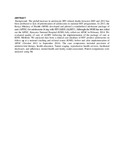Optimising adolescent HIV care in a large Kenyan care and treatment centre

View/
Date
2015-07Author
Gitahi-Kamau, N.
Ilovi, S.
Njagi, L.
Njuguna, E
Mutai, K
Katei, I
Inwani, I.
Mecha, J.
Language
enMetadata
Show full item recordAbstract
Background: The global increase in adolescent HIV-related deaths between 2005 and
2012 has been attributed to lack of prioritization of adolescents in national HIV programmes.
In 2013, the Kenya Ministry of Health (MOH) developed and piloted a standardized adolescent
package of care (APOC) for adolescents living with HIV/AIDS (ALHIV). Although the MOH has
not rolled out the APOC, Kenyatta National Hospital (KNH) fully rolled out APOC in February
2014. We evaluated quality of care of ALHIV following the implementation of the package of
care at KNH. Methods: We analysed data from a clinical care database of HIV positive adolescents
on follow up at a national teaching and referral centre (KNH), before and after implementation
of APOC (October 2012 to September 2014). The care components included provision of
antiretroviral therapy, health education, Tanner staging, reproductive health services, facilitated
disclosure, and adherence, mental health and family social assessment. Paired comparisons
were analysed using Mc’Nemar test on SPSS.
Results: Data on 495 HIV positive adolescents (10-19 years) was analysed. Mean age was
13.6 years (Standard Deviation 2.2 years), and males were 51.8%. The proportion on ART in
the current period was 93.5%, median treatment duration of 68.5 months (Inter Quartile Range
38-87 months). After implementation of the standardised APOC, adherence assessment increased
from 32.6% to 54.0% (p<0.001). Self-reported adherence did not increase significantly
(p = 0.100). There was improved documentation of key clinical care indicators including family
and social status (84.6% to 95.1%, p<0.001), Tanner staging (0.2% to 16%, p<0.001), mental
status (27.7% to 55.7%, p<0.001) and health information provision (0.4% to 52.2%, p<0.001).
Condom provision improved from 5.7% to 9.1%, p=0.047 for all adolescents. Incremental disclosure
assessment increased from 22.3% to 84.4%(p=<0.001). The proportion of adolescents
with completed disclosure increased from 10.9% to 55.3% (p<0.001) after controlling for baseline
age and stage of disclosure.
Conclusions: Implementation of a comprehensive package of care with optimization of
adolescent focussed components can contribute to improved quality of care and outcomes.
Long term impact on treatment outcomes and quality of life of HIV infected adolescents require
further evaluation.
Citation
Gitahi-Kamau, N., Ilovi, S., Njagi, L., Njuguna, E ., Mutai, K., Katei, I., Inwani, I. and Mecha, J(2015). Optimising adolescent HIV care in a large Kenyan care and treatment centre. 8th IAS Conference on HIV pathogenesis, treatment and prevention19 - 22 July 2015. TUPEC538Publisher
University of Nairobi
